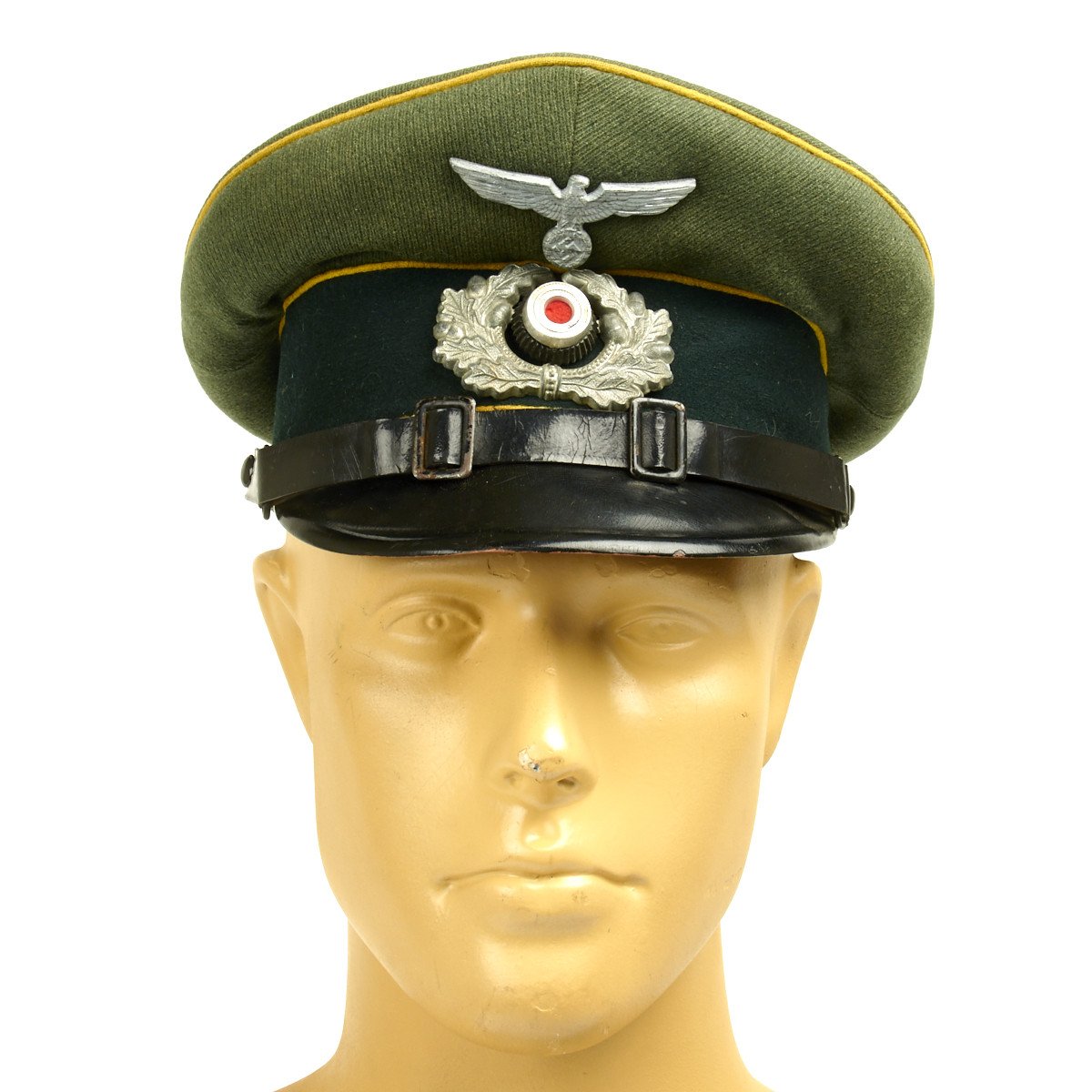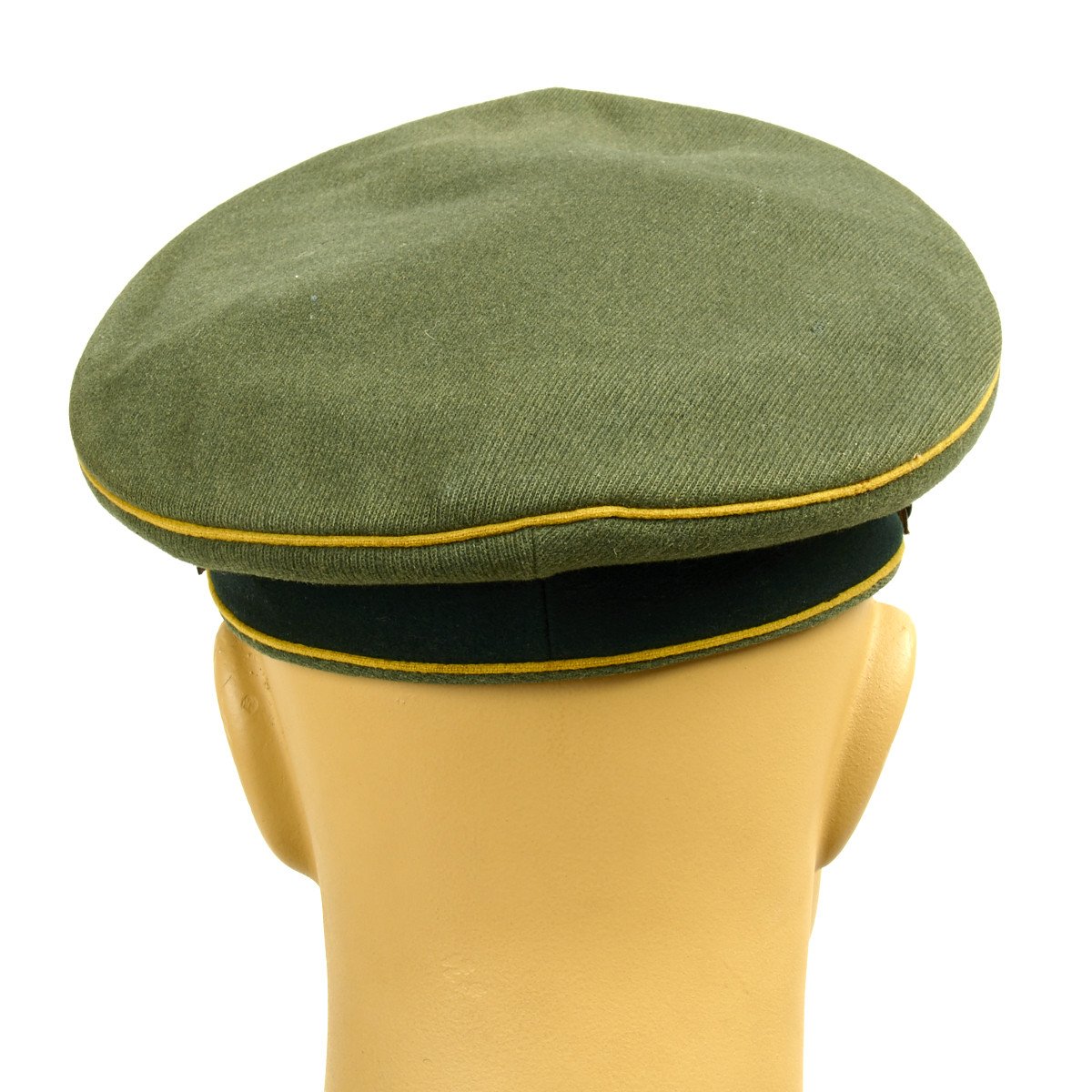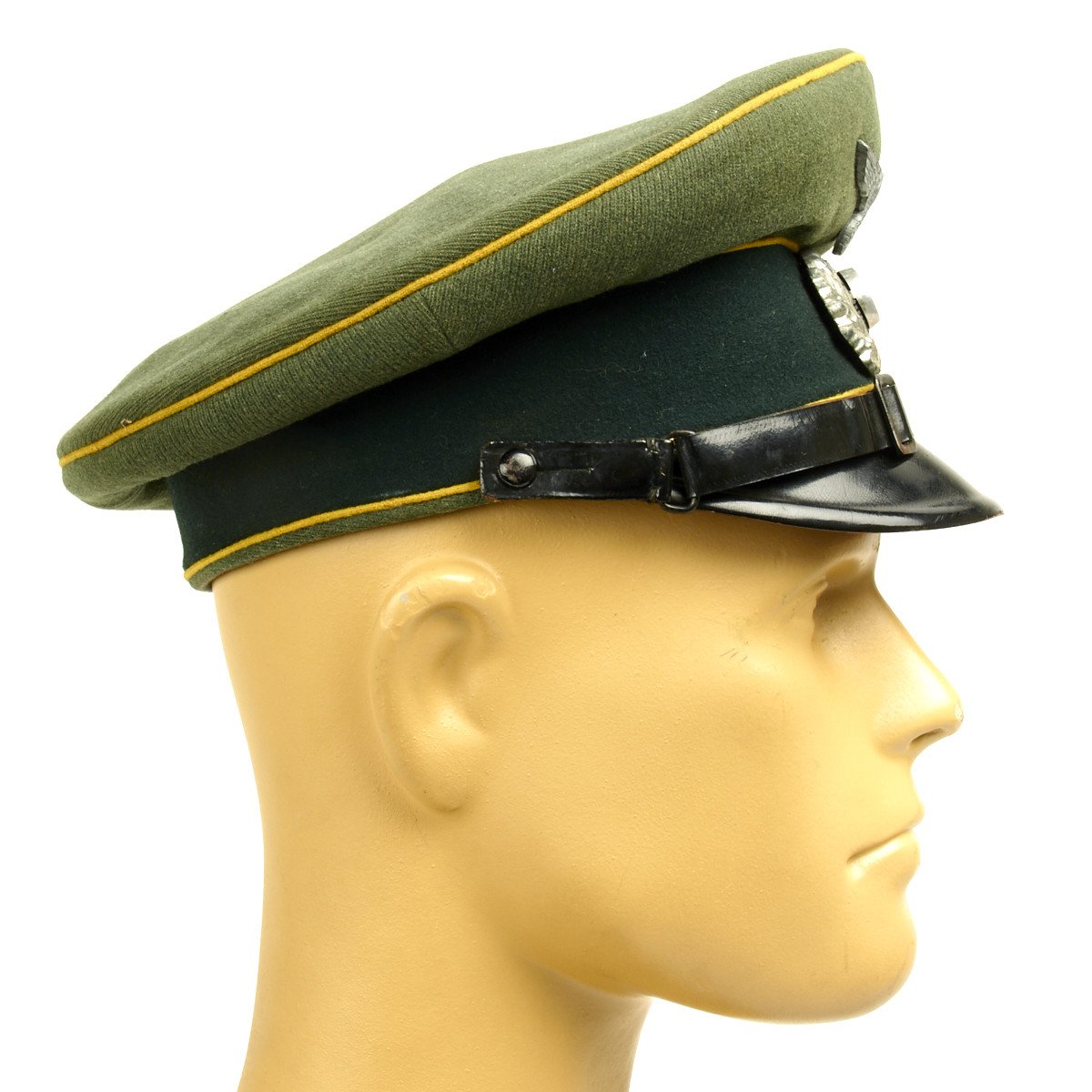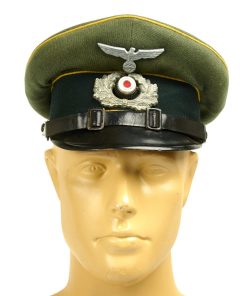Original German WWII Army Heer Signal Corps NCO/EM Visor Cap Original Items
$ 695,00 $ 208,50
Original Item: Only One Available. The Signal Corps or Nachrichtentruppe, in the sense of signal troops, was an arm of service in the army of the German Wehrmacht and Waffen SS, whose role was to establish and operate military communications, especially using telephone and radio networks.
This cap is in typical Heer army green wool with a forest green band and a traditional high peak with matching yellow piping along the top edge and flanking either side of the band, indicating the branch to be the Signal Corps.
It is decorated with a well detailed silvered aluminum eagle insignia on the peak and and an open silvered aluminum wreath surrounding a tri-colour cockade on the band. The dual-buckled black leather chinstrap, designating the wearer to be an enlisted man, is attached to black lacquered buttons on either side. The vulcan visor has a smooth black leather-look upper, exhibiting wear along the edge and is brown on the underside. The brown synthetic leather sweatband is in excellent supple condition.
The inside of the cap is lined in a champagne-colored cotton, with the dome celluloid shield which is unnamed but an ink size stamp of 54 1/2 can be easily seen. The cap shows only light contact on the visor with almost no fabric interruptions or moth nips, remaining in fine condition.
A very nice example of a classic hat worn by a WW2 German Infantry Signal Corps NCO in WW2.
History of the Signal Corps of the Wehrmacht:
During the rearming of the Wehrmacht the first top secret rearmament measures were carried out in spring 1933. These measures included the formation of new units and the establishment of a second signal company in existing units, the recruiting of officer cadets resulting in an eightfold increase over that on 1 April 1933, the reinforcing of the officer and NCO cadre by former signals soldiers, and their training through various courses. From 1934, from the old signal units the required cadre of officers and soldiers was drawn for the establishment of new formations, the divisions of the Wehrmacht each receiving a signal unit. Meanwhile, the Signal Corps steadily expanded its field of expertise; they now had light, medium and heavy telephone troops, telephone exchange and telephone operating troops, telegraph construction troops, light and heavy radio troops, miniature radio troops, two-way radio troops, radio surveillance troops, patrol radio troops, cypher and evaluation troops and battery charging troops.
From 1935, the training of the Signal Corps was carried out at the Army and Air Force Signal School (Heeres- und Luftnachrichtenschule) and, from 1936, the Army Signal School (Heeresnachrichtenschule) in Halle-Dölau. Two central bunker systems were built as communication centres in Zossen and in Ohrdruf.
From a special-to-arm perspective the Corps was led by the Inspector of the Signal Corps (Inspekteur der Nachrichtentruppen) at the Oberkommando des Heeres, the individual formations and units were subordinated to their respective commanders in the field army.
Deployment during the Second World War
The Inspector and General of Signals Erich Fellgiebel, who was executed in 1944 for his part in the 20 July plot against AH, was credited with saying: “The Signal Corps have a tough time. You can’t smell them, they don’t make a noise, most people don’t notice that they exist at all unless the communications stop working.”
Fast Shipping with Professional Packaging
Thanks to our longstanding association with UPS FedEx DHL, and other major international carriers, we are able to provide a range of shipping options. Our warehouse staff is expertly trained and will wrap your products according to our exact and precise specifications. Prior to shipping, your goods will be thoroughly examined and securely secured. We ship to thousands clients each day across multiple countries. This shows how we're dedicated to be the largest retailer on the internet. Warehouses and distribution centres can be located throughout Europe as well as the USA.
Note: Orders with more than one item will be assigned a processing date depending on the item.
Before shipping before shipping, we'll conduct a thorough inspection of the items you have ordered. Today, the majority of orders will be delivered within 48 hours. The delivery time will be between 3-7 days.
Returns
The stock is dynamic and we cannot completely manage it because multiple stakeholders are involved, including our factory and warehouse. So the actual stock may alter at any time. It's possible that you may not receive your order once the order has been made.
Our policy is valid for a period of 30 days. If you don't receive the product within 30 days, we are not able to issue a refund or an exchange.
You can only return an item if it is unused and in the same state as the day you received it. You must have the item in its original packaging.
Related products
Uncategorized
Uncategorized
Armoured Fighting Vehicles of the World: AFVs of World War One (Hardcover Book) New Made Items
Uncategorized
Australian WWII Owen MK1 Machine Carbine SMG Custom Fabricated Replica with Sling Original Items
Uncategorized
Armored Burgonet Helmet & Polearm from Scottish Castle Leith Hall Circa 1700 Original Items
Uncategorized
Uncategorized
Uncategorized
Uncategorized
Uncategorized
Uncategorized
Uncategorized
Uncategorized
Uncategorized
Uncategorized
Uncategorized
Uncategorized
Uncategorized












































































